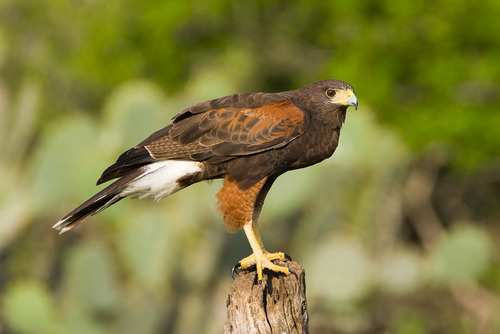
Harris's Hawk
Harris's Hawk (*Parabuteo unicinctus*) is a medium-large bird of prey notable for its striking appearance and unusual cooperative hunting behavior, often likened to that of wolves. Found in the Americas, this raptor plays a crucial role in its ecosystem by controlling populations of rodents and other small animals. It has also become popular in falconry due to its intelligence and ease of training. Unlike many raptors that hunt alone, Harris's Hawks often hunt in family groups, a behavior that increases their success rate.
46-59 cm
Length
103-120 cm
Wingspan
Least Concern
Conservation Status
Distribution
Southwestern United States through Central America and into parts of South America, including Chile and Argentina. They are generally non-migratory, remaining within their breeding ranges year-round.
Lifespan
10-12 years in the wild; up to 20 years in captivity.
Harris's Hawk's Habitat
Habitat Types
Semi-arid brushlands, Savannas, Marshes, Woodlands
Climate Zones
Subtropical, Temperate
Adaptations
Harris's Hawks have adapted to hunting in dense, thorny vegetation with long legs and strong talons, ideal for capturing prey in challenging terrain. They are also well-suited to hotter climates.
Variations
There are three recognized subspecies: *P. u. harrisi* in the US and Mexico, *P. u. superior* in Baja California, and *P. u. unicinctus* in South America. These subspecies show slight variations in size and plumage.
Appearance
Breeding Plumage
Plumage remains consistent throughout the year.
Seasonal Feather Changes
No significant seasonal variations.
Sex Based Plumage Differences
Minimal sexual dimorphism in plumage; both sexes share similar dark brown, chestnut, and white markings.
Notable Features
Dark brown plumage with chestnut shoulders, wing linings, and thighs., White-tipped tail and white undertail coverts., Long, yellow legs and powerful talons.
Diet and Feeding
Primary Foods
Small mammals (rabbits, rodents), Birds, Reptiles (lizards)
Foraging Behavior
Harris's Hawks are renowned for their cooperative hunting strategies. Groups of 2-7 birds work together to flush out and ambush prey. They may use coordinated flight patterns or perch-and-scan tactics.
Specializations
Their cooperative hunting behavior is a significant specialization, allowing them to take down larger prey than they could individually.
Seasonal Diet Variations
Diet may shift slightly based on prey availability, with more birds taken during times when small mammal populations are lower.
Behavior
Social Structure
Harris's Hawks are known for their complex social structure, often living and hunting in family groups. These groups can consist of multiple breeding adults and their offspring.
Communication
Vocalizations, including a variety of calls for communication within the group., Body postures and displays, used during hunting and social interactions.
Migration
Generally non-migratory; they remain within their breeding territories year-round.
Territorial or Group Behaviors
Family groups maintain and defend territories, particularly around nesting sites. Cooperative hunting expands their effective hunting range.
Conservation
Threats
Habitat loss due to agriculture and urbanization., Electrocution on power lines., Illegal shooting., Secondary poisoning from rodenticides.
Protection Programs
Monitoring of populations., Habitat restoration efforts., Public education to reduce human-wildlife conflict.
Local National Laws
Protected under the Migratory Bird Treaty Act in the United States.
Population Trend
Stable
Population Estimates
While precise global estimates are challenging, populations are generally considered stable across most of their range.
Interesting Facts
They are one of only two raptor species known to regularly hunt cooperatively.
This behavior allows them to take down larger prey and increases hunting success.
They are sometimes called the 'Wolves of the Sky'.
This nickname refers to their cooperative hunting behavior, which is similar to that of wolves.
Young Harris's Hawks may stay with their parents for up to three years.
This extended period of parental care helps young birds learn hunting skills.
Faqs about Harris's Hawk
Are Harris's Hawks dangerous to humans?
No, Harris's Hawks are not typically aggressive towards humans unless their nest is threatened.
Can Harris's Hawks be kept as pets?
In some regions, Harris's Hawks are used in falconry, but they require specialized care and permits. They are not suitable as typical pets.
What is the purpose of cooperative hunting?
Cooperative hunting enables the hawks to secure larger or more difficult-to-catch prey and to defend their food source more effectively.
Copyright @ Nature Style Limited. All Rights Reserved.
 English
English